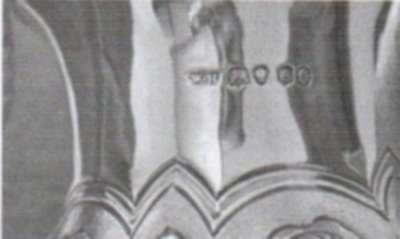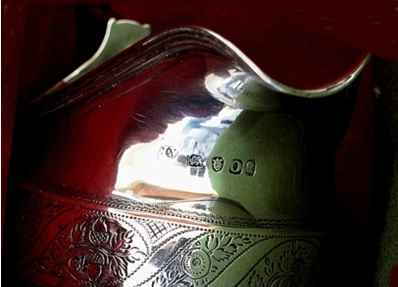(click on photos to enlarge image)
THE DOUBLE MARK PUNCH
USED AT THE LONDON ASSAY OFFICE
On 29th May 1786 John Pingo, the engraver to the Goldsmiths'
Company of London, petitioned the Company for an increase in
salary because of his greatly increased workload. Within this
petition he mentions that: ".....I have also made double
marks on single punches for Tea Spoons...."
(note 1) and these 'Double
Marks' are mentioned in the mark registers from 1785, the first
year in which mark registers (or mark books) were kept.
This double mark takes the form of a date letter in a Norman
shield with canted top corners and a curved base followed by the
sterling lion in an oval cartouche and makes its first
appearance on the mark plate (a sheet of soft metal such as
copper on which the punches used in a given year are struck) in
1782 although it had been used on tea spoons from 1st November
the year before. It disappears from the plate in 1786 when the
fly press mark for tea spoons was introduced.
 |
'double mark' in the
form of a date letter
in a Norman shield with canted top corners
and a curved base followed by the sterling
lion in an oval cartouche (1782)
|
'Duble (sic) marks' were again mentioned in the mark book
entry for 1788 and were for use on rings. Observation of the
mark plate shows that this time the mark took the form of the
duty head followed by the lion.
In 1789, according to the mark book, this punch was used on
buttons, rings and knife hafts and in 1790 there are two
references to it; one for rings and the other unqualified.
Observation shows that this second punch was used on tea tongs (sugar
tongs) and this is useful for dating tongs as this is the only
year in which they were marked in this way since a fly press
mark, for marking tongs, came into use in 1791. Note that the
outline to the lion is now rectangular with canted top corners
and an ogee base.
 |
'double mark' in the
form of
the duty head followed by the lion
|
Although the double mark punch introduced in 1788 was still
being produced in 1792, at this stage it must have been for use
on buttons only as in that year both rings and knife hafts were
being marked by means of the press with a triple mark which was
of this same format but with the addition of the date letter at
the end of the sequence.
By 1792 it had become obvious that double mark punches could be
of great use in the marking of all sorts of other plate and in
that year two other double mark punches were introduced; one
with the lion followed by the leopard, which is in a Norman 'kite'
shield with canted top corners, and the other with date letter
followed by the duty mark.
 |
 |
Goblet by William
Hewitt London 1837/8 showing use of two
double mark punches used on curved surfaces.
|
Not only were these marks used on some hollow ware, on the
curved surfaces of which the press could not be used, but they
proved most useful in the marking of plate for which the usual
marks were not appropriate.
 |
Britannia standard
Marks on a teaspoon by Richard Britton
London 1835/6 showing that a double mark punch was
used
to impress the date letter and the duty mark rather
than the fly press
stub which would otherwise have been used
(Photograph produced by kind permission of
A.B.L.Dove F.S.A.)
|
The image below shows the marks on a sterling standard
teaspoon of the same date for comparison.
 |
Fly pressed sterling
standard hallmarks on a teaspoon assayed
in London in 1835/6
|
Recognition of these double marks can be of considerable
assistance to the collector in, for instance, determining the
date of a piece. Photo below is of a milk jug by Andrew
Fogelberg and has the date letter "O" for either 1789/90 or
1809/10. Close examination of the marks reveals that, whereas
the lion and leopard marks have been individually punched, the
date letter and the duty mark have been applied by means of a
double mark punch so that the jug must have been assayed after
1792. Its assay date is, therefore, 1809/10.
 |
Milk jug by Andrew
Fogelberg London 1809/10 showing that
a double mark punch carrying the date letter and
duty mark
has been used to mark this piece.
|
By the turn of the century the idea of the double mark punch
was well established and in 1813 a unique and rather delicate
little mark was introduced for marking pendants on which no duty
was payable. This took the form of a double diamond or lozenge
in the first half of which was the date letter and in the second
the sterling lion. This mark appears not only to be unique in
its design but is also smaller than any other mark that I have
yet come across. I imagine that it is also somewhat uncommon.
By 1818 a double mark punch comprising a lion within a rectangle
with canted top corners and an ogee base followed by a date
letter within a similar outline had also been introduced in two
sizes but there is no indication on the mark plate that it was
to be used in combination with another double mark punch and it
may, therefore, have been intended for partial marking.
NB: Hollow ware such as tea pots and caddies were marked
underneath at this time and the marks were thus still hand
punched in clock face fashion since such pieces could not be
accommodated in a fly press.
ACKNOWLEDGEMENT
I am greatly indebted to the Worshipful Company of Goldsmiths
for extending to me research facilities.
Some of the information in this article was first published
under the title "The Introduction of Double Mark Punches" in
"The Finial" (the journal of The Silver Spoon Club of Great
Britain) in June/July 2003).
David McKinley
- 2012 -
David McKinley devotes much of his time to
researching the history of silversmithing in England
with particular reference to hallmarking at the London
office. He writes for both The Silver Spoon Club of
Great Britain and The Silver Society.
David McKinley is the author of the book THE FIRST
HUGUENOT SILVERSMITHS OF LONDON
Information about the content of this book and the
discounted price applied to members of ASCAS is
available in
September 2011 Newsletter
|
|







